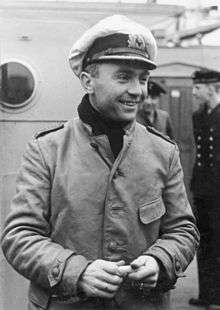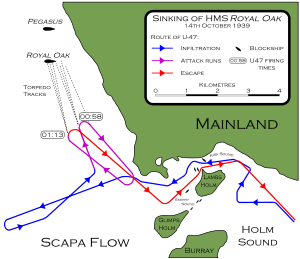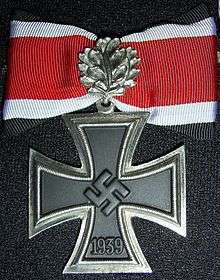Günther Prien
| Günther Prien | |
|---|---|
 | |
| Nickname(s) | Der Stier von Scapa Flow |
| Born |
16 January 1908 Osterfeld |
| Died |
7 March 1941 (aged 33) 200 miles south of Iceland |
| Buried at | (approximately 60°N 19°W / 60°N 19°W) |
| Allegiance |
|
| Service/branch |
|
| Years of service | 1933–41 |
| Rank | Korvettenkapitän |
| Service number | NSDAP #1,128,487 |
| Unit | 7th U-boat Flotilla |
| Commands held | U-47 |
| Battles/wars |
|
| Awards | Knight's Cross of the Iron Cross with Oak Leaves |
Günther Prien (16 January 1908 – presumed 7 March 1941) was a German U-boat commander during World War II. He was the first U-boat commander to receive the Knight's Cross of the Iron Cross and the first member of the Kriegsmarine to receive the Knight's Cross of the Iron Cross with Oak Leaves of Nazi Germany. It was Germany's highest military decoration at the time of its presentation to Prien.
Under Prien's command, the submarine U-47 was credited in Nazi propaganda with sinking over 30 Allied ships totaling about 200,000 gross register tons (GRT). He sank the British battleship HMS Royal Oak at anchor in the Home Fleet's anchorage in Scapa Flow.
Early naval career
Prien was one of three children of a judge. Prien joined the Handelsflotte (German Merchant marine) in mid-1923 After several years of work and study as a seaman, Prien passed the required examinations and became the Fourth Officer on a passenger liner. Prien received his sea captain's license in January 1932.
Unable to find work due to the severe contraction of the German shipping industry during the Great Depression, he was forced to turn to the Assistance Board for sustenance. Angry with what he considered to be an inept government, which seemed impotent in the face of the country's economic disaster, he joined the Nazi Party in May 1932.[1] Donald Macintyre described Prien as "the most Nazified U-boat captain", "an ardent ruthless Nazi" (article, p 32 onwards, in issue 4 of War Monthly, Marshall Cavendish 1974). In August 1932 Prien joined the voluntary labor corps of Vogtsberg at Olsnitz where he rose to the rank of deputy to the camp commander.
Prien applied to the Reichsmarine in 1933; he served on a light cruiser and then was posted to the U-Boat training school at Kiel. Upon graduation, he was posted to U-26 at the Deutsche Schiff- und Maschinenbau AG (Deschimag) Yard in Bremen as First Watch Officer, serving under the command of Werner Hartmann. U-26 went on two patrols in 1937 (6 May – 15 June and 15 July – 30 August) during the Spanish Civil War. Prien rose steadily in rank, from midshipman in 1933 to Oberleutnant zur See (Senior lieutenant at Sea) in 1937. He was appointed to the command of the new Type VIIB U-47 on her commissioning in December 1938 and promoted to Kapitänleutnant (Captain lieutenant) in February 1939. Prien married in 1939; the couple had two children.
World War II
First patrol
World War II commenced during Prien's first patrol in U-47. He departed Kiel on 19 August 1939 for a patrol lasting 28 days. On 5 September, he sank the British SS Bosnia of 2,407 gross register tons (GRT), the second ship of the war to be sunk by a U-boat. His boat sank two British vessels, Rio Claro of 4,086 GRT on the 6th, and Gartavon of 1,777 GRT on the 7th. U-47 returned to Kiel on 15 September having sunk a total tonnage of 8,270 GRT.
Second patrol: Scapa Flow

On 14 October 1939, Prien's boat penetrated the Royal Navy's primary base, Scapa Flow and sank the battleship Royal Oak. He returned to Germany to instant fame. He was awarded the Knight's Cross of the Iron Cross, personally by Adolf Hitler, the first sailor of the U-boat service and the second member of the Kriegsmarine to receive this award. Prien received the nickname Der Stier von Scapa Flow ("The Bull of Scapa Flow"); the emblem of a snorting bull was painted on the conning tower of U-47 and soon became the emblem of the entire 7th U-boat Flotilla. Two members of the Scapa Flow crew earned the Knight's Cross of the Iron Cross during World War II: the chief engineer (Leitender Ingenieur) Johann-Friedrich Wessels and 1st watch officer (I. Wachoffizier) Engelbert Endrass.
Kept secret by the German naval command was the fact that Prien had fired a total of seven torpedoes at his target, of which five failed because of long-standing problems with their depth steering and their magnetic detonator systems. These problems continued to bedevil the German submariners for a long time and particularly during the German invasion of Norway, when the U-boats were unable to keep the Royal Navy at bay. Prien narrated the attack in the book Mein Weg nach Scapa Flow (1940, Deutscher Verlag Berlin).
Third patrol
U-47 under the command of Prien with 1st watch officer (I. WO) Oberleutnant zur See Engelbert Endrass and chief engineer Oberleutnant (Ing.) Johann-Friedrich Wessels left Kiel on 16 November 1939.[2] U-47 attacked a British cruiser on 28 November 1939. Prien had identified the ship to be a London-class cruiser. Prien intended to launch a spread of three torpedoes, but only a single torpedo cleared the tube and detonated in the wake of the cruiser. When the periscope cleared the surface, Prien observed what he believed major damage to the stern of the cruiser, her starboard torpedo launchers dislogded and an aircraft tilted. U-47 surfaced and tried to pursue the cruiser but was driven off by depth charges dropped from the escort. It turned out the cruiser was HMS Norfolk which was slightly damaged by the detonation.[3] The attack was reported in the daily Wehrmachtbericht on 29 November 1939, claiming the destruction of the cruiser. The war diary of the Befehlshaber der U-Boote (BdU) on 17 December 1939 stated that even though a hit was observed the cruiser was not sunk.[2]
On 5 December 1939, U-47 spotted nine merchant vessels escorted by five destroyers. At 14:40, Prien fired one torpedo ,[4] sinking the British steamer Navasota from Convoy OB 46 on its way to Buenos Aires, killing 37 sailors. [5] After sinking Navasota, British destroyers attacked U-47 alas without success.[6] The next day at 20:29 the Norwegian tanker Britta was sunk[7] killing 6 of her crew [8] followed by the Dutch Tajandoen on 7 December 1939.[9][10] U-47 continued to attack Allied shipping in the Western Approaches, however eight out of twelve G7e U-47 carried, failed to detonate either missing or malfunctioning.[6] On 18 December 1939, U-47 returned to Kiel via the Kaiser Wilhelm Canal. The claims made by Prien are noted in the war diary of the BdU on 17 December 1939:
for a total of 31,000 GRT plus one British warship damaged, while the actual tonnage was only 23,168 GRT.[2]
Later career
Amongst the ships sunk by U-47 was the SS Arandora Star, carrying over 1,200 German and Italian civilian internees and 86 German prisoners of war to captivity in Canada. Over 800 lives were lost.
Following later patrols and raids on Allied merchant shipping, Prien was awarded the Oak Leaves to the Knight's Cross in 1940.
Heinz Rühmann, Hans Brausewetter and Josef Sieber sang a persiflage of the 1939 song Das kann doch einen Seemann nicht erschüttern (That won't shake a sailor), written by Michael Jary from the film Paradies der Junggesellen—Bachelor's Paradise, on account of the Oak Leaves presentation to Prien. The reworded lyrics are Das muss den ersten Seelord doch erschüttern—That must shake the First Sea Lord, alluding to Winston Churchill.[11][Note 1]
U-47 went missing on 7 March 1941 while attacking Convoy OB-293. She has generally been thought to have been sunk by the British destroyer HMS Wolverine west of Ireland; the submarine was attacked by Wolverine and HMS Verity, which took turns covering each other's ASDIC blind spots and dropping patterns of depth charges until U-47 rose almost to the surface before sinking and then exploded with an orange flash visible from the surface.[12]
To date, there is no official record of what happened to U-47 or her 45 crewmen, though a variety of possibilities exists, including mines, a mechanical failure, falling victim to her own torpedoes, and possibly a later attack that did not confirm any kills by the corvette team of HMS Camellia and HMS Arbutus.[13][14][15]
Prien's death was kept secret until 23 May.[12] Churchill had personally announced it to the House of Commons, and propaganda broadcasts to Germany had repeatedly taunted listeners with the question "Where is Prien?" until Germany was forced to acknowledge his loss.[16]
Although Prien was at sea for less than two years, his record stands high among the U-boat aces during the Second World War. He spent 238 days at sea and sank 30 enemy vessels for a total tonnage of 193,808 GRT.
In popular culture
The 1958 war film U 47 – Kapitänleutnant Prien, directed by Harald Reinl, was loosely based on Prien's combat record and command of U-47. Prien was portrayed by the German actor Dieter Eppler.[17]
Prien was a subject of a hagiographic 1981 account by German author Franz Kurowski, Günther Prien, der Wolf und sein Admiral (Günther Prien, the Wolf and his Admiral). The German scholar Hans Wagener classifies Kurowski's book, published by extreme right-wing publisher Druffel Verlag, as an "almost perfect example of a skillful distillation of the Nazi understanding of the Second World War".[18] The Canadian historian Michael Hadley commented on narrative's goals as follows:[19]
Here he [Kurowski] wished to commemorate the "meritorious soldier and human being Günther Prien [who is] forgotten neither by the old submariners nor" —and this would have startled most observers in Germany today [in 1995] —"by the young submariners of the Federal German Navy".
Günther Prien had been considered as namesake for the 1967 commissioned guided missile destroyer Lütjens. However the legend surrounding Prien, that he had distanced himself from Nazism and had become an active member of the German resistance and was held captive at the Wehrmachtgefängnis Torgau (Torgau Wehrmacht Prison), turned out to be false. Consequently, the name Lütjens, named after Admiral Günther Lütjens, was chosen instead.[20]
Summary of career
Ships attacked
During his career Prien sank 30 commercial ships for 162,769 GRT, one warship of 29,150 GRT, and damaged eight commercial ships for 62,751 GRT and one warship of 10,035 long tons (10,196 t).
Awards
- Wehrmacht Long Service Award 4th Class (22 January 1937)[22]
- Iron Cross (1939)
- U-boat War Badge with Diamonds[24]
- Diamond-studded Navy Honour Dagger[24]
- Knight's Cross of the Iron Cross with Oak Leaves
- Knight's Cross on 18 October 1939 as Kapitänleutnant and commander of U-47[25][26]
- 5th Oak Leaves on 20 October 1940 as Kapitänleutnant and commander of U-47[25][27]
- Mentioned eight times in the Wehrmachtbericht (29 November 1939, 28 June 1940, 1 July 1940, 6 July 1940, 10 September 1940, 25 September 1940, 20 October 1940 and 23 May 1941)
Notes
- ↑ First Sea Lord at the time was Admiral Dudley Pound. However, Churchill was the personified British enemy at the time.
References
Citations
- ↑ Mulligan 2013, chpt. 11 Disinterested Service
- 1 2 3 Busch & Röll 2003, p. 18.
- ↑ Thomas Weis. "Records of attack on HMS Norfolk". Axis Submarine Successes, 1939-1945. Retrieved 1 August 2016.
- ↑ Thomas Weis. "Records of attack on SS Navasota". Axis Submarine Successes, 1939-1945. Retrieved 1 August 2016.
- ↑ Helgason, Guðmundur. "Ships hit by U-boats: Navasota". German U-boats of WWII - uboat.net. Retrieved 1 August 2016.
- 1 2 Clay Blair (2010). Hitler's U-Boat War: The Hunters, 1939-1942. Random House. p. 120. ISBN 978-0-30787-437-5.
- ↑ Thomas Weis. "Records of attack on MT Britta". Axis Submarine Successes, 1939-1945. Retrieved 1 August 2016.
- ↑ Helgason, Guðmundur. "Ships hit by U-boats: Britta". German U-boats of WWII - uboat.net. Retrieved 1 August 2016.
- ↑ Thomas Weis. "Records of attack on MS Tajandoen". Axis Submarine Successes, 1939-1945. Retrieved 1 August 2016.
- ↑ Helgason, Guðmundur. "Ships hit by U-boats: Tajandoen". German U-boats of WWII - uboat.net. Retrieved 1 August 2016.
- ↑ Ossmann-Mausch 2006, p. 151.
- 1 2 Van der Vat 2000, p. 212.
- ↑ Blair 1996, pp. 249-253.
- ↑ Kemp 1997, p. 68.
- ↑ Neistle 1998, pp. 39, 223.
- ↑ Williams 2003, pp. 124–126.
- ↑ U47 - Kapitänleutnant Prien at the Internet Movie Database. Retrieved 16 January 2012.
- ↑ Wagener 1997, p. 664.
- ↑ Hadley 1995, p. 129.
- ↑ "Mumm haben". Der Spiegel 35/1967. Retrieved 4 November 2012.
- ↑ "BOSNIA CARGO - VRACHTSCHIP 1928-1939 - WRAK WRECK EPAVE WRACK PECIO". Wrecksite.eu. Retrieved 29 October 2012.
- 1 2 3 Busch & Röll 2003, p. 15.
- 1 2 Thomas 1998, p. 171.
- 1 2 Williamson & Bujeiro 2004, p. 23.
- 1 2 Scherzer 2007, p. 604.
- ↑ Fellgiebel 2000, p. 344.
- ↑ Fellgiebel 2000, p. 53.
Bibliography
- Clay Blair (2010). Hitler's U-Boat War: The Hunters, 1939-1942. Random House. ISBN 978-0-30787-437-5.
- Busch, Rainer; Röll, Hans-Joachim (2003). Der U-Boot-Krieg 1939–1945 — Die Ritterkreuzträger der U-Boot-Waffe von September 1939 bis Mai 1945 [The U-Boat War 1939–1945 — The Knight's Cross Bearers of the U-Boat Force from September 1939 to May 1945] (in German). Hamburg, Berlin, Bonn Germany: Verlag E.S. Mittler & Sohn. ISBN 978-3-8132-0515-2.
- Fellgiebel, Walther-Peer (2000) [1986]. Die Träger des Ritterkreuzes des Eisernen Kreuzes 1939–1945 — Die Inhaber der höchsten Auszeichnung des Zweiten Weltkrieges aller Wehrmachtteile [The Bearers of the Knight's Cross of the Iron Cross 1939–1945 — The Owners of the Highest Award of the Second World War of all Wehrmacht Branches] (in German). Friedberg, Germany: Podzun-Pallas. ISBN 978-3-7909-0284-6.
- Hadley, Michael L. (1995). Count Not the Dead: The Popular Image of the German Submarine. Montreal: McGill-Queen's University Press. ISBN 9780773512825.
- Kemp, Paul (1997). U-Boats Destroyed. ISBN 1-85409-515-3.
- Neistle, Axel (1998). German U-Boat Losses during World War II. ISBN 1-85367-352-8.
- Mulligan, Timothy (2013). Neither Sharks Nor Wolves: The Men of Nazi Germany's U-boat Army, 1939–1945. Naval Institute Press. ISBN 978-1-61251-080-4.
- Ossmann-Mausch, Christa A. (2006). Alles begann in Berlin: eine Jugend in Zeiten des Krieges (in German). Hamburg, Germany: Mein Buch oHG. ISBN 3-86516-493-5.
- Prien, Günther (1969). U-Boat Commander. Deutscher Verlag.
- Scherzer, Veit (2007). Die Ritterkreuzträger 1939–1945 Die Inhaber des Ritterkreuzes des Eisernen Kreuzes 1939 von Heer, Luftwaffe, Kriegsmarine, Waffen-SS, Volkssturm sowie mit Deutschland verbündeter Streitkräfte nach den Unterlagen des Bundesarchives [The Knight's Cross Bearers 1939–1945 The Holders of the Knight's Cross of the Iron Cross 1939 by Army, Air Force, Navy, Waffen-SS, Volkssturm and Allied Forces with Germany According to the Documents of the Federal Archives] (in German). Jena, Germany: Scherzers Militaer-Verlag. ISBN 978-3-938845-17-2.
- Thomas, Franz (1998). Die Eichenlaubträger 1939–1945 Band 2: L–Z [The Oak Leaves Bearers 1939–1945 Volume 2: L–Z] (in German). Osnabrück, Germany: Biblio-Verlag. ISBN 978-3-7648-2300-9.
- Van der Vat, Dan (2000). Standard of Power. London: Hutchinson. ISBN 0-09-180121-4.
- Williams, Andrew (2003). The Battle of the Atlantic: Hitler's Gray Wolves of the Sea and the Allies' Desperate Struggle to Defeat Them. New York: Basic Books. ISBN 0-465-09153-9.
- Williamson, Gordon; Bujeiro, Ramiro (2004). Knight's Cross and Oak Leaves Recipients 1939–40. Oxford, UK: Osprey Publishing. ISBN 978-1-84176-641-6.
- Die Wehrmachtberichte 1939–1945 Band 1, 1. September 1939 bis 31. Dezember 1941 [The Wehrmacht Reports 1939–1945 Volume 1, 1 September 1939 to 31 December 1941] (in German). München, Germany: Deutscher Taschenbuch Verlag GmbH & Co. KG. 1985. ISBN 978-3-423-05944-2.

